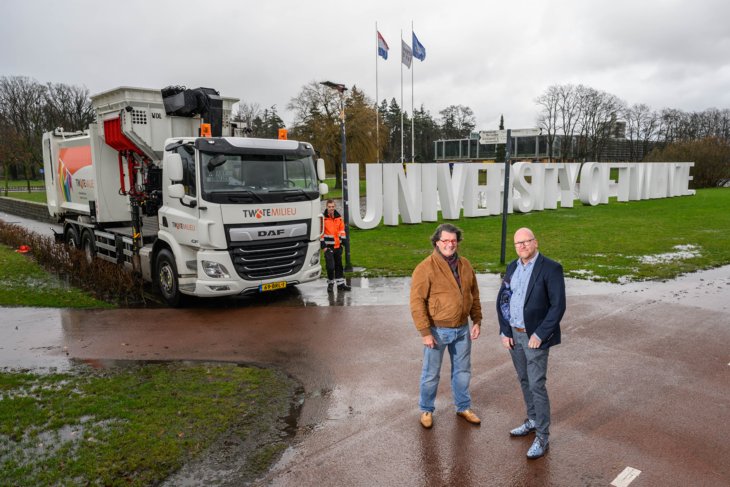To this end, Twente Milieu engaged a research team from the University of Twente. A fruitful collaboration, which through practical research, data and algorithms yielded even better collection routes. Because, Twente Milieu's managing director Charles Vinke and manager business office and equipment Remco Vriesema emphasise, the waste collection company's route planners already had their routes in order. 'Our intuition said, 'we're doing it right, but we're not sure',' Charles explains. 'That's why I asked Professor Richard Boucherie of the University of Twente for help.'
Richard is professor of Stochastic Operations Research and chairman of Data Science & AI Lab and MKB Datalab Oost-Nederland, which use 'operations research' and artificial intelligence (AI) to answer data-oriented questions.
SURPRISED
The professor was pleasantly surprised by the research question Charles submitted to him and his colleagues on behalf of Twente Milieu. 'Such a question indicates that they are doing well as a company. That they are leading the way. Something that was also confirmed during the course of the project,' says Richard. Twente Milieu not only had a question, but was also open to question clarification from the University of Twente, he noticed.
'Our researchers Maik Overmars and Matthias Walter soon realised that there were several components behind the central research question, such as the optimal distribution of rubbish collection days across neighbourhoods in order to get by with as few rubbish trucks as possible and the shortest routes for rubbish trucks within a neighbourhood.' Remco: 'They worked a lot together with our experienced staff Raymond Degenhart and Jos Smook, who had the role of project leader in this study.'
Narrow streets
To create an efficient route, planners have to deal with external factors. For example, different restrictions apply per municipality, as not every municipality has the same waste collection policy. 'In addition, Twente Milieu works with two types of vehicles, each with its own possibilities and impossibilities: rear loaders (rubbish trucks where the minicontainer is emptied at the back) and side loaders (trucks with a robotic arm on the side). 'A side loader can empty containers on only one side of the street at a time, and in narrow streets Twente Milieu rubbish trucks cannot always make the turn,' Richard says.
On top of that, Twente Milieu collects each waste flow at a different frequency: 'We collect vegetable, fruit and garden waste on a regular basis, while in the case of diftar containers, for which residents pay per emptying, the number of containers put on the street is different each time. All these things affect our planning,' says Remco. Richard adds: 'The huge number of minicontainers, often several for different types of waste per address, makes figuring out ideal routes extremely challenging.'
AI METHODS
University of Twente developed a unique model, which uses algorithms to calculate the optimal route for drivers. Richard: 'The foundation is an automated map, based on OpenStreetMap. To this, we linked Twente Milieu's database using data science and AI. This allows you to see per address which minicontainers there are, but also which collection days apply and which types of waste are involved. Using state-of-the-art insights from 'operations research', we then developed a mathematical algorithm to find the best route through a neighbourhood within a reasonable calculation time. We can also modify, remove or add data. The algorithm then automatically recalculates the optimal routes.'
TEST IN PRACTICE
The theoretically ideal routes were tested in practice. 'We compared the existing routes, about a thousand in total, with the optimal routes calculated by our mathematical algorithm,' says Richard. Researcher Maik went along on the rubbish truck several times. As a result of the research, Twente Milieu's rear loaders can now drive ten per cent fewer kilometres and side loaders five per cent less. 'Together we have come very close to optimal routes. We can even use one less rubbish truck per day. Another advantage is that this also makes it easier and better to schedule employees.'
MORE insights
Remco is happy with the confirmation the survey provided. 'Our route planning was already good and the survey has given us insights to optimise it even further. In addition, thanks to the map, our planners now have a starting point if a new district comes up in the future or a change in a route.' Richard adds: 'A planner still has to see if a theoretically ideal route is actually ideal in practice; our model is a decision support system. Man and algorithm arrive at a better solution together. Our solution is not only applicable to Twente Milieu, but to all waste collectors in the Netherlands.'
SCIENTIFIC ARTICLE
Looking back, Richard looks back on the cooperation with Twente Milieu with great pleasure and enthusiasm. 'The project is a great example of how co-creation of science and implementation provides insight into practical issues. From CEO to rubbish truck driver and from planner to researcher, everyone brought their knowledge and expertise to this project. Not only did we deliver a solution for Twente Milieu, we also wrote a scientific paper on the mathematical model.'




